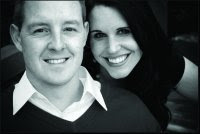I highly recommend the book, because I won't be able to explain everything in perfect detail on this blog. And you'll learn all kinds of interesting facts about bread science, the anatomy of a wheat kernel, wild yeast, and enzymes. However, because so many of my friends and family have asked...How Did You Do It? Here's a quick run down...from Wheat to Eat.
I grind my own wheat into flour using the Grain Mill (Stand Mixer) Attachment to the KitchenAid. By far my favorite attachment (ok, my only attachment thus far). Using the Grain Mill, I can either crack the wheat for a delicious breakfast cereal, or in this case, grind it into a fine powder perfect for bread making.
Reinhart's recipe does require that I plan ahead; that's the whole secret behind delayed fermentation. The night before I want to consume a delicious loaf of whole grain bread, I create what's called a Soaker as well as a Biga.
Day 1: The Soaker consists of whole wheat flour, salt, and my delicious homemade yogurt (milk or buttermilk may be used instead)
After mixing the soaker ingredients together, I cover loosely with plastic wrap and leave at room temperature for 12 to 24 hours.
Day 1: The Biga consists of whole wheat flour, instant yeast, and filtered water. Also mixed, covered tightly with plastic wrap, and put into the refrigerator overnight. Then, in the morning removed from the refrigerator approximately 2 hours before mixing the final dough, to take off the chill.
Day 2: I use a metal pastry scraper to chop both the Soaker and the Biga into smaller pieces, ready for use in the final dough
Day 2: The Final Dough consists of the Soaker, the Biga, additional whole wheat flour, salt, instant yeast, honey or agave and unsalted butter, melted
After mixing...
Do a little more kneading...
Then place it in a bowl to rise.
Transfer to lightly floured work surface
Shape the loaf
Transfer to Pan
Let rise again
Finally Bake, using a Steam Pan (optional)
Let cool, before serving....if you can :)
100% Whole Grain Bread Never Tasted, Nor Looked, SOOO Good!






































































